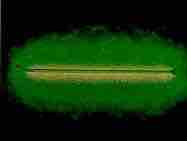A variety of contaminants can affect the quality of indoor air and the health of the people who inhabit that space. One serious source of indoor air pollution is radon. Radon is a dense, colorless, odorless noble gas that occurs naturally in the soil as the product of the radioactive decay of radium; it is a decay product of uranium and thorium, which occur naturally in the Earth's crust.

Radon gas
A gold tube filled with radon gas.
Sources of Radon
Radon has a variety of sources, including uranium, and contains rocks like granite, shale, phosphate rock, and pitchblende. Radon can escape from these sources and migrate into the surrounding air and water supplies. It can be found in well water, natural gas sources, and building materials. Radon sources are found throughout the United States, in houses, schools, and businesses that have been constructed on top of radon-rich soil. Due to its heavy density, radon typically floats downward and is often found in the basements of buildings.
Health Effects
Radon is a major source of indoor air pollution and is the cause of tens of thousands of deaths annually in the United States and Europe. Radon decays to form daughters, or decay products, which include radioactive polonium, lead, and bismuth. Radon is a gas, but these decay products are solids that can attach to dust and enter the lungs. Radon and its daughters continue to decay in the lungs, releasing alpha and beta particles that can damage cellular DNA and result in lung cancer. Radon and its daughters are the leading cause of lung cancer in non-smokers.
Detection and Prevention
Radon levels can be tested through a number of available assays, and contamination can be addressed by sealing basements and cellars to prevent the exchange of gas with the surrounding soil or by increasing ventilation. Many states require radon testing before selling a house.